RAM CHASSIS CAB 2021 Owners Manual
Manufacturer: RAM, Model Year: 2021, Model line: CHASSIS CAB, Model: RAM CHASSIS CAB 2021Pages: 463, PDF Size: 21.5 MB
Page 321 of 463
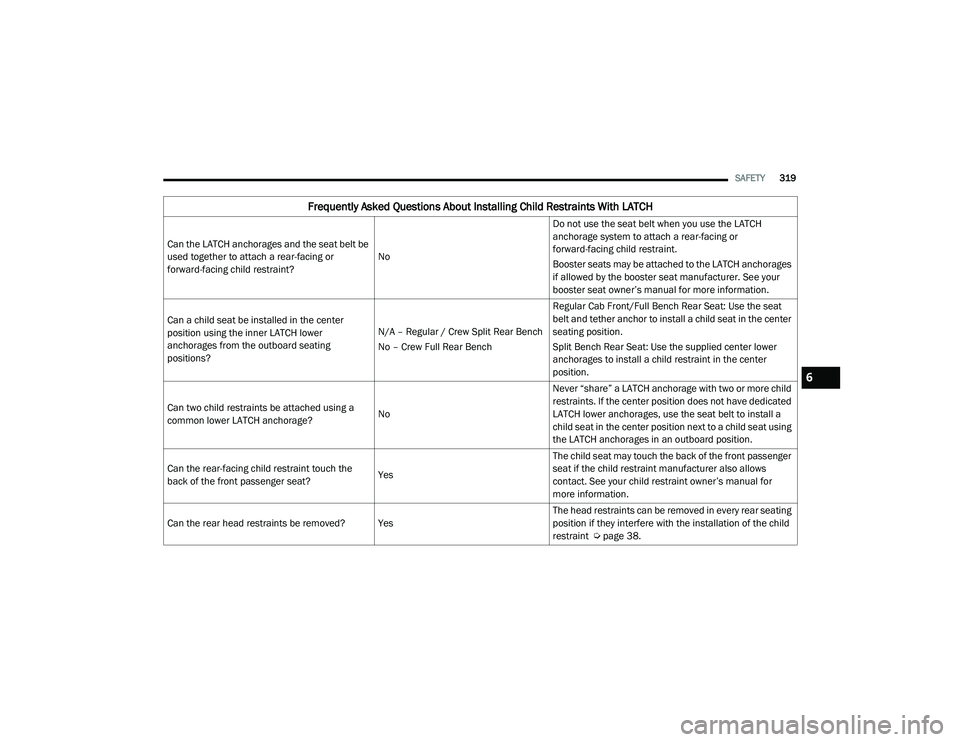
SAFETY319
Can the LATCH anchorages and the seat belt be
used together to attach a rear-facing or
forward-facing child restraint? NoDo not use the seat belt when you use the LATCH
anchorage system to attach a rear-facing or
forward-facing child restraint.
Booster seats may be attached to the LATCH anchorages
if allowed by the booster seat manufacturer. See your
booster seat owner’s manual for more information.
Can a child seat be installed in the center
position using the inner LATCH lower
anchorages from the outboard seating
positions? N/A – Regular / Crew Split Rear Bench
No – Crew Full Rear BenchRegular Cab Front/Full Bench Rear Seat: Use the seat
belt and tether anchor to install a child seat in the center
seating position.
Split Bench Rear Seat: Use the supplied center lower
anchorages to install a child restraint in the center
position.
Can two child restraints be attached using a
common lower LATCH anchorage? NoNever “share” a LATCH anchorage with two or more child
restraints. If the center position does not have dedicated
LATCH lower anchorages, use the seat belt to install a
child seat in the center position next to a child seat using
the LATCH anchorages in an outboard position.
Can the rear-facing child restraint touch the
back of the front passenger seat? YesThe child seat may touch the back of the front passenger
seat if the child restraint manufacturer also allows
contact. See your child restraint owner’s manual for
more information.
Can the rear head restraints be removed? Yes The head restraints can be removed in every rear seating
position if they interfere with the installation of the child
restraint Ú
page 38.
Frequently Asked Questions About Installing Child Restraints With LATCH
6
21_DPF_OM_EN_USC_t.book Page 319
Page 322 of 463
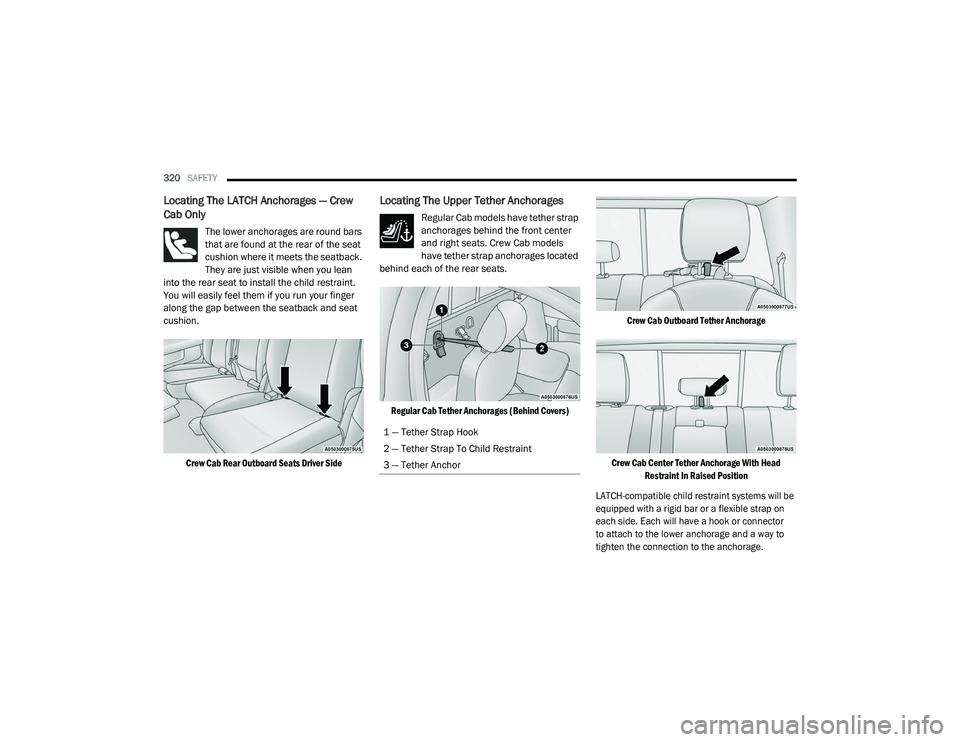
320SAFETY
Locating The LATCH Anchorages — Crew
Cab Only
The lower anchorages are round bars
that are found at the rear of the seat
cushion where it meets the seatback.
They are just visible when you lean
into the rear seat to install the child restraint.
You will easily feel them if you run your finger
along the gap between the seatback and seat
cushion.
Crew Cab Rear Outboard Seats Driver Side
Locating The Upper Tether Anchorages
Regular Cab models have tether strap
anchorages behind the front center
and right seats. Crew Cab models
have tether strap anchorages located
behind each of the rear seats.
Regular Cab Tether Anchorages (Behind Covers) Crew Cab Outboard Tether Anchorage
Crew Cab Center Tether Anchorage With Head Restraint In Raised Position
LATCH-compatible child restraint systems will be
equipped with a rigid bar or a flexible strap on
each side. Each will have a hook or connector
to attach to the lower anchorage and a way to
tighten the connection to the anchorage.
1 — Tether Strap Hook
2 — Tether Strap To Child Restraint
3 — Tether Anchor
21_DPF_OM_EN_USC_t.book Page 320
Page 323 of 463

SAFETY321
Forward-facing child restraints and some
rear-facing child restraints will also be equipped
with a tether strap. The tether strap will have a
hook at the end to attach to the top tether
anchorage and a way to tighten the strap after
it is attached to the anchorage.
Center Seat LATCH
Regular Cab or Crew Cab Full Bench Rear Seat:
No Lower Center LATCH Anchorages Available Crew Cab Split Bench Rear Seat: Center LATCH
Anchorages Available
If a child restraint installed in the center
position blocks the seat belt webbing or buckle
for the outboard position, do not use that
outboard position. If a child seat in the center
position blocks the outboard LATCH anchors or
seat belt, do not install a child seat in that
outboard position.
Always follow the directions of the child
restraint manufacturer when installing your
child restraint. Not all child restraint systems
will be installed as described here.
To Install A LATCH-Compatible Child
Restraint
If the selected seating position has a
Switchable Automatic Locking Retractor (ALR)
seat belt, stow the seat belt, following the instructions below. See Ú
page 322 to check
what type of seat belt each seating position has.
1. Loosen the adjusters on the lower straps and on the tether strap of the child seat so
that you can more easily attach the hooks
or connectors to the vehicle anchorages.
2. Place the child seat between the lower anchorages for that seating position. If the
second row seat can be reclined, you may
recline the seat and/or raise the head
restraint (if adjustable) to get a better fit.
If the rear seat can be moved forward and
rearward in the vehicle, you may wish to
move it to its rear-most position to make
room for the child seat. You may also move
the front seat forward to allow more room
for the child seat.
3. Attach the lower hooks or connectors of the child restraint to the lower anchorages in
the selected seating position.
4. If the child restraint has a tether strap, connect it to the top tether anchorage.
See Ú page 327 for directions to attach a
tether anchor.
WARNING!
Do not install a child restraint in the center
position using the LATCH system. This posi -
tion is not approved for installing child
seats using the LATCH attachments.
You must use the seat belt and tether
anchor to install a child seat in the center
seating position.
Never use the same lower anchorage to
attach more than one child restraint.
For typical installation instructions, see
Ú page 321.
WARNING!
Never use the same lower anchorage to attach
more than one child restraint. For typical
installation instructions, see
Ú
page 321.
6
21_DPF_OM_EN_USC_t.book Page 321
Page 324 of 463

322SAFETY
5. Tighten all of the straps as you push the
child restraint rearward and downward into
the seat. Remove slack in the straps
according to the child restraint
manufacturer’s instructions.
6. Test that the child restraint is installed tightly by pulling back and forth on the child
seat at the belt path. It should not move
more than 1 inch (25.4 mm) in any
direction.
How To Stow An Unused Switchable-ALR
(ALR) Seat Belt:
When using the LATCH attaching system to
install a child restraint, stow all ALR seat belts
that are not being used by other occupants or
being used to secure child restraints. An unused
belt could injure a child if they play with it and
accidentally lock the seat belt retractor. Before
installing a child restraint using the LATCH
system, buckle the seat belt behind the child
restraint and out of the child’s reach. If the buckled seat belt interferes with the child
restraint installation, instead of buckling it
behind the child restraint, route the seat belt
through the child restraint belt path and then
buckle it. Do not lock the seat belt. Remind all
children in the vehicle that the seat belts are not
toys and that they should not play with them.
Installing Child Restraints Using The
Vehicle Seat Belt
Child restraint systems are designed to be
secured in vehicle seats by lap belts or the lap
belt portion of a lap/shoulder belt.
WARNING!
Improper installation of a child restraint to
the LATCH anchorages can lead to failure of
the restraint. The child could be badly
injured or killed. Follow the child restraint
manufacturer’s directions exactly when
installing an infant or child restraint.
Child restraint anchorages are designed to
withstand only those loads imposed by
correctly-fitted child restraints. Under no
circumstances are they to be used for adult
seat belts, harnesses, or for attaching other
items or equipment to the vehicle.
WARNING!
Improper installation or failure to properly
secure a child restraint can lead to failure
of the restraint. The child could be badly
injured or killed.
Follow the child restraint manufacturer’s
directions exactly when installing an infant
or child restraint.
21_DPF_OM_EN_USC_t.book Page 322
Page 325 of 463
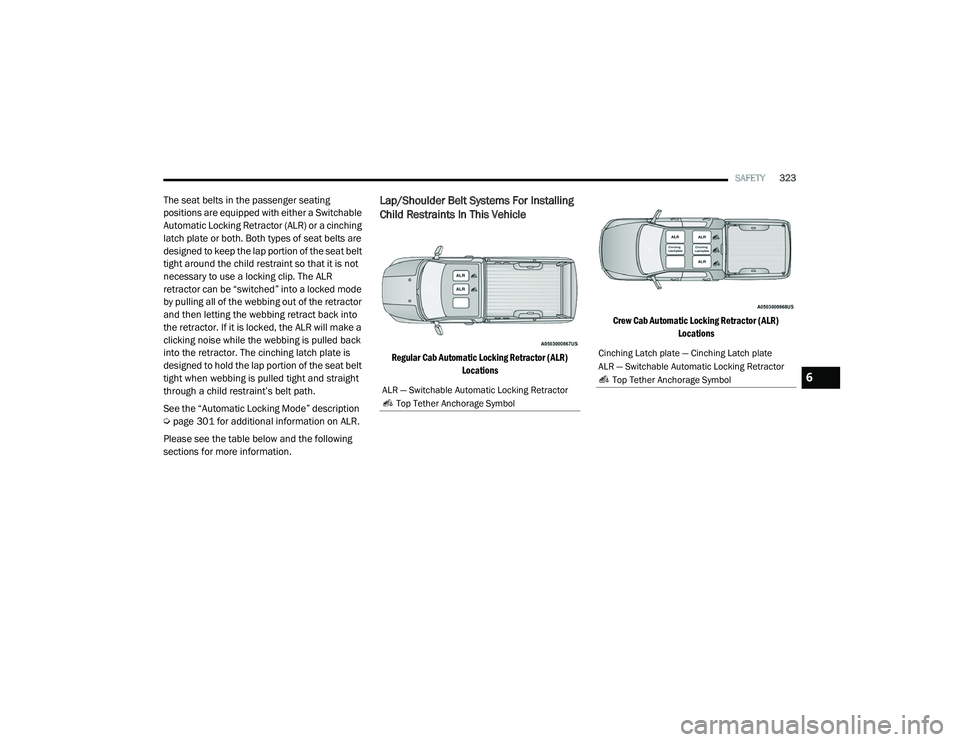
SAFETY323
The seat belts in the passenger seating
positions are equipped with either a Switchable
Automatic Locking Retractor (ALR) or a cinching
latch plate or both. Both types of seat belts are
designed to keep the lap portion of the seat belt
tight around the child restraint so that it is not
necessary to use a locking clip. The ALR
retractor can be “switched” into a locked mode
by pulling all of the webbing out of the retractor
and then letting the webbing retract back into
the retractor. If it is locked, the ALR will make a
clicking noise while the webbing is pulled back
into the retractor. The cinching latch plate is
designed to hold the lap portion of the seat belt
tight when webbing is pulled tight and straight
through a child restraint’s belt path.
See the “Automatic Locking Mode” description
Úpage 301 for additional information on ALR.
Please see the table below and the following
sections for more information.Lap/Shoulder Belt Systems For Installing
Child Restraints In This Vehicle
Regular Cab Automatic Locking Retractor (ALR) Locations Crew Cab Automatic Locking Retractor (ALR)
Locations
ALR — Switchable Automatic Locking Retractor
Top Tether Anchorage Symbol
Cinching Latch plate — Cinching Latch plate
ALR — Switchable Automatic Locking Retractor Top Tether Anchorage Symbol
6
21_DPF_OM_EN_USC_t.book Page 323
Page 326 of 463
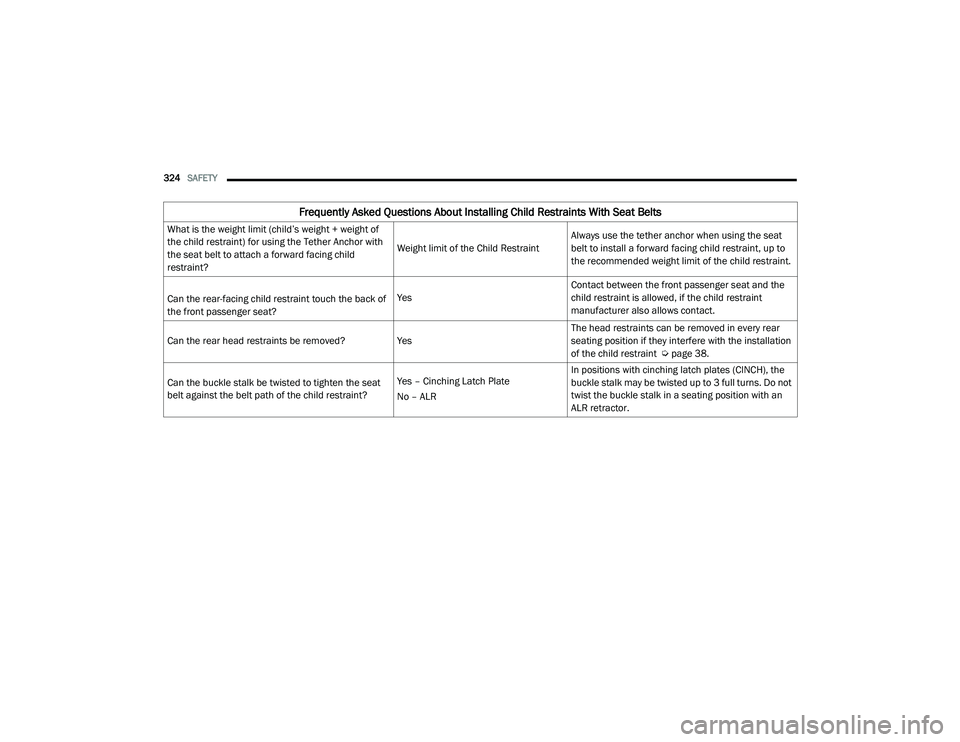
324SAFETY
Frequently Asked Questions About Installing Child Restraints With Seat Belts
What is the weight limit (child’s weight + weight of
the child restraint) for using the Tether Anchor with
the seat belt to attach a forward facing child
restraint? Weight limit of the Child Restraint
Always use the tether anchor when using the seat
belt to install a forward facing child restraint, up to
the recommended weight limit of the child restraint.
Can the rear-facing child restraint touch the back of
the front passenger seat? Yes
Contact between the front passenger seat and the
child restraint is allowed, if the child restraint
manufacturer also allows contact.
Can the rear head restraints be removed? YesThe head restraints can be removed in every rear
seating position if they interfere with the installation
of the child restraint Ú
page 38.
Can the buckle stalk be twisted to tighten the seat
belt against the belt path of the child restraint? Yes – Cinching Latch Plate
No – ALRIn positions with cinching latch plates (CINCH), the
buckle stalk may be twisted up to 3 full turns. Do not
twist the buckle stalk in a seating position with an
ALR retractor.
21_DPF_OM_EN_USC_t.book Page 324
Page 327 of 463

SAFETY325
Installing A Child Restraint With A
Switchable Automatic Locking Retractor
(ALR):
Child restraint systems are designed to be
secured in vehicle seats by lap belts or the lap
belt portion of a lap/shoulder belt.
1. For Crew Cab Models
Place the child seat in the center of the
seating position. If the second row seat can
be reclined, you may recline the seat and/or
raise the head restraint (if adjustable) to get
a better fit. If the rear seat can be moved
forward and rearward in the vehicle, you
may wish to move it to its rear-most position
to make room for the child seat. You may
also move the front seat forward to allow
more room for the child seat. For Regular Cab Models
Place the child seat in the center of the
seating position. Move the vehicle seat as
far rearward as possible to keep the child as
far from the passenger air bag as possible.
2. Pull enough of the seat belt webbing from the retractor to pass it through the belt path
of the child restraint. Do not twist the belt
webbing in the belt path.
3. Slide the latch plate into the buckle until you hear a “click.”
4. Pull on the webbing to make the lap portion tight against the child seat.
5. To lock the seat belt, pull down on the shoulder part of the belt until you have
pulled all the seat belt webbing out of the
retractor. Then, allow the webbing to retract
back into the retractor. As the webbing
retracts, you will hear a clicking sound.
This means the seat belt is now in the
Automatic Locking mode. 6. Try to pull the webbing out of the retractor.
If it is locked, you should not be able to pull
out any webbing. If the retractor is not
locked, repeat step 5.
7. Finally, pull up on any excess webbing to tighten the lap portion around the child
restraint while you push the child restraint
rearward and downward into the vehicle
seat.
8. If the child restraint has a top tether strap and the seating position has a top tether
anchorage, connect the tether strap to
the anchorage and tighten the tether strap.
See Ú page 327 for directions to attach a
tether anchor.
9. Test that the child restraint is installed tightly by pulling back and forth on the child
seat at the belt path. It should not move
more than 1 inch (25.4 mm) in any
direction.
Any seat belt system will loosen with time, so
check the belt occasionally, and pull it tight if
necessary.
WARNING!
Improper installation or failure to properly
secure a child restraint can lead to failure
of the restraint. The child could be badly
injured or killed.
Follow the child restraint manufacturer’s
directions exactly when installing an infant
or child restraint.6
21_DPF_OM_EN_USC_t.book Page 325
Page 328 of 463
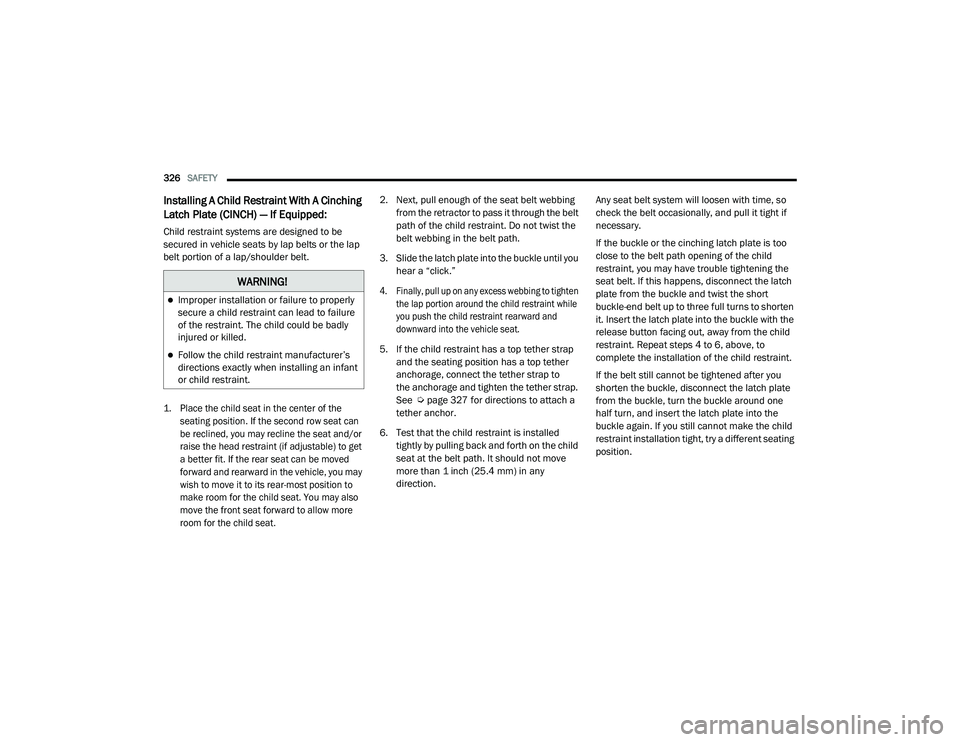
326SAFETY
Installing A Child Restraint With A Cinching
Latch Plate (CINCH) — If Equipped:
Child restraint systems are designed to be
secured in vehicle seats by lap belts or the lap
belt portion of a lap/shoulder belt.
1. Place the child seat in the center of the
seating position. If the second row seat can
be reclined, you may recline the seat and/or
raise the head restraint (if adjustable) to get
a better fit. If the rear seat can be moved
forward and rearward in the vehicle, you may
wish to move it to its rear-most position to
make room for the child seat. You may also
move the front seat forward to allow more
room for the child seat.
2. Next, pull enough of the seat belt webbing
from the retractor to pass it through the belt
path of the child restraint. Do not twist the
belt webbing in the belt path.
3. Slide the latch plate into the buckle until you hear a “click.”
4. Finally, pull up on any excess webbing to tighten the lap portion around the child restraint while
you push the child restraint rearward and
downward into the vehicle seat.
5. If the child restraint has a top tether strap and the seating position has a top tether
anchorage, connect the tether strap to
the anchorage and tighten the tether strap.
See Ú page 327 for directions to attach a
tether anchor.
6. Test that the child restraint is installed tightly by pulling back and forth on the child
seat at the belt path. It should not move
more than 1 inch (25.4 mm) in any
direction. Any seat belt system will loosen with time, so
check the belt occasionally, and pull it tight if
necessary.
If the buckle or the cinching latch plate is too
close to the belt path opening of the child
restraint, you may have trouble tightening the
seat belt. If this happens, disconnect the latch
plate from the buckle and twist the short
buckle-end belt up to three full turns to shorten
it. Insert the latch plate into the buckle with the
release button facing out, away from the child
restraint. Repeat steps 4 to 6, above, to
complete the installation of the child restraint.
If the belt still cannot be tightened after you
shorten the buckle, disconnect the latch plate
from the buckle, turn the buckle around one
half turn, and insert the latch plate into the
buckle again. If you still cannot make the child
restraint installation tight, try a different seating
position.
WARNING!
Improper installation or failure to properly
secure a child restraint can lead to failure
of the restraint. The child could be badly
injured or killed.
Follow the child restraint manufacturer’s
directions exactly when installing an infant
or child restraint.
21_DPF_OM_EN_USC_t.book Page 326
Page 329 of 463
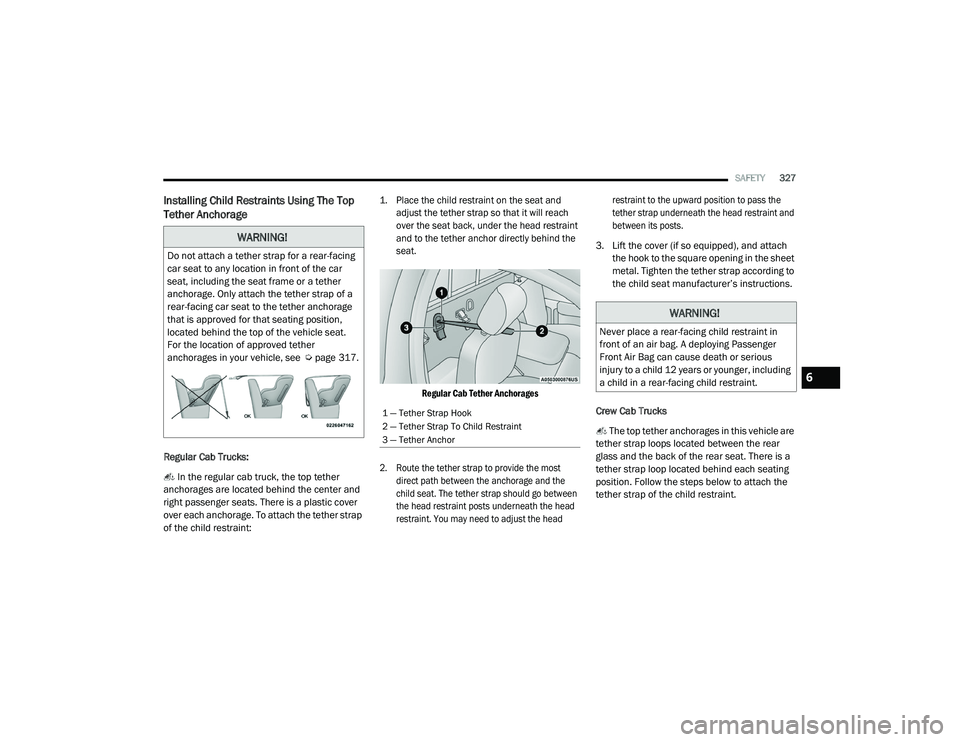
SAFETY327
Installing Child Restraints Using The Top
Tether Anchorage
Regular Cab Trucks:
In the regular cab truck, the top tether
anchorages are located behind the center and
right passenger seats. There is a plastic cover
over each anchorage. To attach the tether strap
of the child restraint:
1. Place the child restraint on the seat and
adjust the tether strap so that it will reach
over the seat back, under the head restraint
and to the tether anchor directly behind the
seat.
Regular Cab Tether Anchorages
2. Route the tether strap to provide the most direct path between the anchorage and the
child seat. The tether strap should go between
the head restraint posts underneath the head
restraint. You may need to adjust the head restraint to the upward position to pass the
tether strap underneath the head restraint and
between its posts.
3. Lift the cover (if so equipped), and attach the hook to the square opening in the sheet
metal. Tighten the tether strap according to
the child seat manufacturer’s instructions.
Crew Cab Trucks The top tether anchorages in this vehicle are
tether strap loops located between the rear
glass and the back of the rear seat. There is a
tether strap loop located behind each seating
position. Follow the steps below to attach the
tether strap of the child restraint.
WARNING!
Do not attach a tether strap for a rear-facing
car seat to any location in front of the car
seat, including the seat frame or a tether
anchorage. Only attach the tether strap of a
rear-facing car seat to the tether anchorage
that is approved for that seating position,
located behind the top of the vehicle seat.
For the location of approved tether
anchorages in your vehicle, see Ú page 317.
1 — Tether Strap Hook
2 — Tether Strap To Child Restraint
3 — Tether Anchor
WARNING!
Never place a rear-facing child restraint in
front of an air bag. A deploying Passenger
Front Air Bag can cause death or serious
injury to a child 12 years or younger, including
a child in a rear-facing child restraint.
6
21_DPF_OM_EN_USC_t.book Page 327
Page 330 of 463

328SAFETY
Right Or Left Outboard Seats:
1. Raise the head restraint and reach
between the rear seat and rear glass to
access the tether strap loop.
Head Restraint In Raised Position
Tether Strap Loop With Center Head Restraint In Raised Position 2. Place a child restraint on the seat and adjust
the tether strap so that it will reach over the
seat back, under the head restraint, through
the tether strap loop behind the seat and
over to the tether strap loop behind the
center seat.
3. Pass the tether strap hook under the head restraint behind the child seat, though the
tether strap loop behind the seat and over
to the center tether strap loop.
Tether Strap Through Outboard Tether Strap Loop
4. Attach the hook to the center tether strap loop (see diagram). Tighten the tether strap
according to the child seat manufacturer’s
instructions.
Tether Strap Through Outboard Tether Strap Loop And
Attached To Center Tether Strap Loop
NOTE:
If there are child seats in both of the outboard
(left and right) seating positions, the tether
strap hooks of both child seats should be
connected to the center tether strap loop.
This is the correct way to tether two outboard
child seats.
21_DPF_OM_EN_USC_t.book Page 328